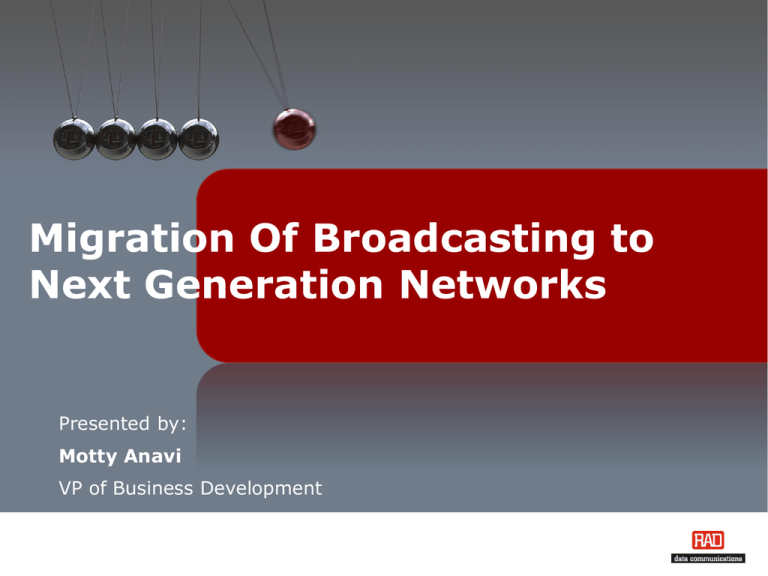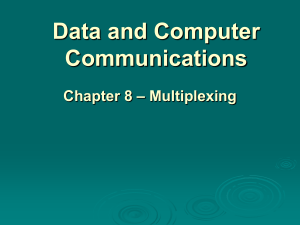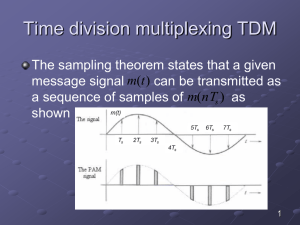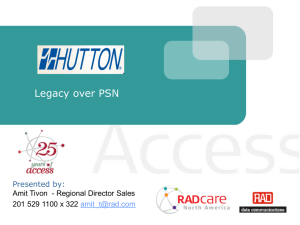Migration Of Broadcasting to Next Generation Networks
advertisement

Migration Of Broadcasting to Next Generation Networks Presented by: Motty Anavi VP of Business Development Agenda • Challenges in migrating to Next Generation networks • Technology enablers • Standards • Applications • Summary PW Broadcast 2010 Slide 2 Traditional Broadcast Telco Use ISDN ISDN CODEC CODEC T1 TDM Network POTS T1 POTS • Broadcast is encoded digitally • Transferred via either: • Digital telco transmission line • Built-in modem to POTS line PW Broadcast 2010 Slide 3 Changes in Telco Services • Availability of traditional services is diminishing • ISDN almost completely eliminated • Many POTS lines are converted to VoIP • Availability of Next Generation networks is increasing dramatically • Vendors are MD-ing TDM products • New CODECs come in IP versions PW Broadcast 2010 Slide 4 The Changing Landscape ISDN ? ? ISDN TDM PSN Network CODEC T1 ? ? T1 POTS ? ? POTS CODEC • How can EXISTING broadcast equipment be maintained using the new PSN? PW Broadcast 2010 Slide 5 What is Pseudowire (PW)? • Pseudo = Simulated, Seemingly • Emulation of a native service over a Packet Switched Network (PSN) • The native services can be ATM, TDM, Frame Relay or ETH, while the PSN can be ETH, IP or MPLS • Supports voice, data and video • Provides a transparent tunnel through the PSN • Provides clock distribution and synchronization over PSN PW Broadcast 2010 Slide 6 What is a Pseudowire (PW)? PSN Network ATM VCC PW Gateway PW Gateway ATM VCC HDLC HDLC TDM TDM PW Broadcast 2010 Slide 7 PW Switching- IP/ETH 1. User services are mapped to PW VCC/T1 PW-Label 2. IP headers added T1-TDM VCC/T1 PW-Label Switching is done according to the IP addresses T1-TDM IP Header PW Gateway VCC PW Gateway ETH ETH IP/ETH Network VCC VCC VCC 3. The IP Header is stripped VCC/T1 PW-Label IP Header 4. PW label mapped back to user services VCC/T1 PW-Label PW Broadcast 2010 Slide 8 PW Switching – MPLS/ETH 1. User services are mapped to PW VCC/T1 Switching is done according to the Tunnel Label PW-Label 2. Tunnel Label added T1-TDM VCC/T1 PW-Label T1-TDM Tunnel Label PW Gateway VCC PW Gateway ETH ETH VCC MPLS VCC VCC 3. The Tunnel Label is stripped VCC/T1 PW-Label Tunnel Label 4. PW Label mapped back to user services VCC/T1 PW-Label PW Broadcast 2010 Slide 9 Pseudowire (PW) Product Offerings • Preserves investment in legacy TDM/ATM equipment in migration to PSN • Lowers OpEx of TDM/ATM service by utilizing packet infrastructure • Ultimate voice quality (no compression, no conversion) TDM Service PW Gateway Packet Network PW Gateway TDM Service Pseudowire PW Broadcast 2010 Slide 10 PW Solution – Private Line / Leased Line over Packet Application: • Carrying broadcast traffic over PSN network Benefits: • Uses PSN to provide voice services • Saves leased line costs by using a single line for voice and data • Preserves legacy TDM equipment, features and functionalities ISDN ISDN T1 T1 CODEC CODEC POTS PSN Network POTS PW Broadcast 2010 Slide 11 PW Broadcast 2010 Slide 12 TDM Pseudowire Services Unframed TDMoIP or SAToP over PSN • T1/E1 line is a 2.048/1.544 Mbps bit stream • Full transparency to the TDM traffic • No multi-bundling • End-to-end framing sync • TDMoIP standard: IETF – ietf-pwe3-tdmoip • SAToP standard: draft-ietf-pwe3-satop- Structure-Agnostic TDM over Packet PBX PBX PW Gateway PW Gateway ETH ETH/IP/ MPLS Network ETH PW Broadcast 2010 Slide 13 TDM Pseudowire Services (cont.) Framed TDMoIP or CESoPSN • Framed T1/E1 • Multi-bundling • TS0/Fbit termination • Local framing sync • TDMoIP standard: IETF – ietf-pwe3-tdmoip • CESoPSN: draft-ietf-pwe3-cesopsn.txt - Structure-Aware TDM Circuit Emulation Service over PSN PBX PBX PW Gateway PW Gateway ETH Framing Sync ETH/IP/ MPLS Network ETH Framing Sync PW Broadcast 2010 Slide 14 TDMoIP Payload Size ETH IP UDP CW CRC TDM/HDLC Payload • TDMoIP Unframed/Framed payload size is between 48-1440 bytes n x 48 bytes (where n=1,2,3,……,30) • CESoPSN & SAToP payload size is between 32-512 bytes according to the number of time slots in a bundle (configurable) Payload configuration: N – Number of time slots in a bundle L – Packet payload size in bytes • L should be multiple integer (m) of number of time slots in the bundle (N) L=mxN • HDLCoIP mechanism monitors the data stream until a frame (data) is detected (flag) PW Broadcast 2010 Slide 15 Pseudowire Standards Standard Application IETF ITU-T MFA TDMoIP TDM circuit emulation ietf-pwe3-tdmoip Y.1413, Y.1453, Y.1414, Y.1452 IA 4.0 CESoPSN TDM circuit emulation ietf-pwe3cesopsn Y.1413, Y.1453 IA 8.0 MEF 8 SAToP TDM circuit emulation RFC4553 Y.1413, Y.1453 None MEF 8 HDLCoPSN HDLC transport RFC4618 None None None ATMoPSN ATM service transport RFC4717 Y.1411, Y.1412 None None FRoPSN Frame Relay service emulation RFC4619 X.84 None None IA 5.0 MEF MEF 8 • RAD is actively involved in most of the standardization bodies PW Broadcast 2010 Slide 16 Extending TDM via Ethernet Radio Transmitter Location Distribution Center T1 PW Gateway Ethernet Microwave Link ETH ETH PW Gateway T1 • Extends broadcast audio to a remote transmitter site • Cost effective solution by using extremely affordable Ethernet microwave radio • Uses existing CODECs over T1 Pseudowire • Effective range – up to 40 miles PW Broadcast 2010 Slide 17 Distributing Content over IP Remote Station Distribution Center POP/HUB/CO PWE Gateway T1 ETH ETH/IP/ MPLS Network PW Gateway T1 Remote Station • Large PW gateway in Center • Has the capability to break-up a single T1 or send multiple T1s ETH PW Gateway T1 • IP/MPLS network is more cost effective when going long distances • Fully redundant central site solution PW Broadcast 2010 Slide 18 TDM Pseudowire Product Line Products Ethernet Service Network Link Standards 1 x T1/E1, 1 x T3/E3 Provided by the host switch Provided by the host switch CESoPSN SAToP 4 x FXS/FXO/E&M 1 user port Rate limit (optional) 1 UTP/Fiber Fast Ethernet TDMoIP 1x FE UTP/SFP TDMoIP CESoPSN SAToP 2 x FE/GE, UTP/SFP TDMoIP CESoPSN SAToP 4 GbE ports (UTP or SFP) with LAG SAToP 2 UTP or SFP GE TDMoIP CESoPSN SAToP TDM Service MiTOP IPmux-1E 4 x BRI IPmux-2L /4L 1/2 /4 x E1 Nx64 serial port (2L only) IPmux-24 1/2/4 x T1/E1 2 x User - Rate limiting - VLAN tag+stack 1 x User, 1 x Net/User - Rate limiting IPmux-216 8 or 16 x T1/E1 - VLAN tag+stack - MEF 9&14 EPL IPmux-155L 2 x STM-1 Gmux-2000 196 x T1/E1 or 2 x C.OC-3/STM-1 or 7 x C.T3 32 FE user ports (UTP or SFP) FE Management PW Broadcast 2010 Slide 19 Summary • The changing landscape of Telco services is forcing changes to the way broadcasters use these services • Pseudowire technology allows broadcasters to continue to use existing voice equipment while replacing Telco infrastructure • Pseudowire technology is established and mature to a point where it is becoming widely used • RAD has experience dealing with the various issues that arise with the use of Pseudowire technology Over 110,000 TDM over IP ports installed since 2000 Over 50,000 TDM over IP ports installed in the last 2 years only! PW Broadcast 2010 Slide 20 Thank you for your attention www.rad.com PW Broadcast 2010 Slide 21







